There’s no denying it, we’re seeing fewer and fewer hardtails on the start line at cross-country events, thanks in part to how tough the tracks have become.
But while full-suspension mountain bikes can add comfort and confidence, many riders still yearn for that solid connection between the front and rear triangles, and the efficiency and urgency only the best hardtails can provide when stamping on the pedals.
You only need to look at some of the bikes being raced in the World Cup XC Short Track (XCC) series to see this. Cérvelo, for example, has been replacing the rear shock of its ZFS-5 full-suspension bike with a solid link, effectively turning it into a hardtail.
The shock has then been slotted back in ahead of the longer Olympic-distance XCO race a couple of days later (with the same bike needing to be used for both events).
This compromised approach may well pay off when putting the power down, but could throw a spanner in the works when things get technical on the track.

So, how do you balance efficiency and power transfer with grip and control? Can you have your cake and eat it? Trek and Specialized seem to think so.
Their latest XC race machines promise the feel of a hardtail when you’re on the gas, but should still offer the bump absorption and more forgiving, traction-rich ride you’d expect from a full-suspension bike.
The two brands have approached frame and suspension design slightly differently, although the end goal is similar. Which is best, and should we be bidding the cross-country hardtail a fond farewell?
To find out, Tom Marvin’s been hammering the Specialized S-Works Epic World Cup on UK singletrack loops, as well as taking on a multi-day marathon event in Menorca.
Meanwhile, Rob Weaver has been using the Trek Supercaliber SLR 9.9 XX AXS Gen 2 for mixed local laps with steep, treacherous sections and fast-paced, rough trail-centre rides.
After comparing notes, chasing each other around the trails and, finally, swapping between the bikes, they’ve reached their verdicts.
Introducing the bikes
Specialized S-Works Epic World Cup
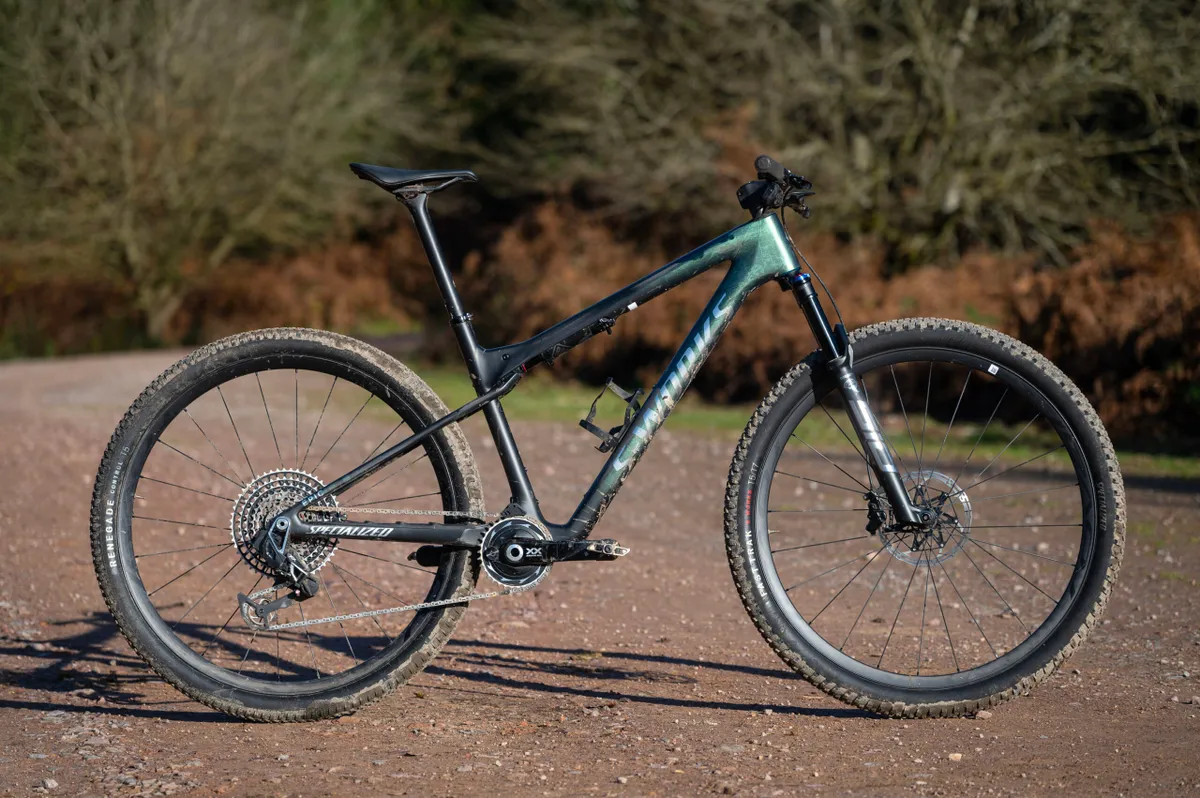
The Specialized Epic World Cup is the bike the Big S believes is going to replace the XC hardtail.
The World Cup sits alongside the longer-travel, more traditional Epic in Specialized’s line-up.
The brand says its 75mm of rear suspension gives you the snap out of the gate of the best hardtails, with at least some of the smoothing characteristics of its full-suspension sibling.
While 75mm doesn’t sound like much, the bike is designed to be run with minimal sag (zero to 10 per cent), so you should get almost as much usable travel as on a 100mm full-supension bike run with 25 per cent sag.
The custom RockShox shock gives you control over the negative air spring to alter the suspension characteristics of the bike.
You can switch to No Gulp for a full-throttle zero-sag, hardtail-feeling race rig, or give yourself the Full Gulp treatment with 10 per cent sag for top grip and a smoother ride. There’s a 5 per cent setting, too.
A 110mm fork, carbon finishing kit and flyweight hoops complete the picture.
Trek Supercaliber SLR 9.9 XX AXS Gen 2
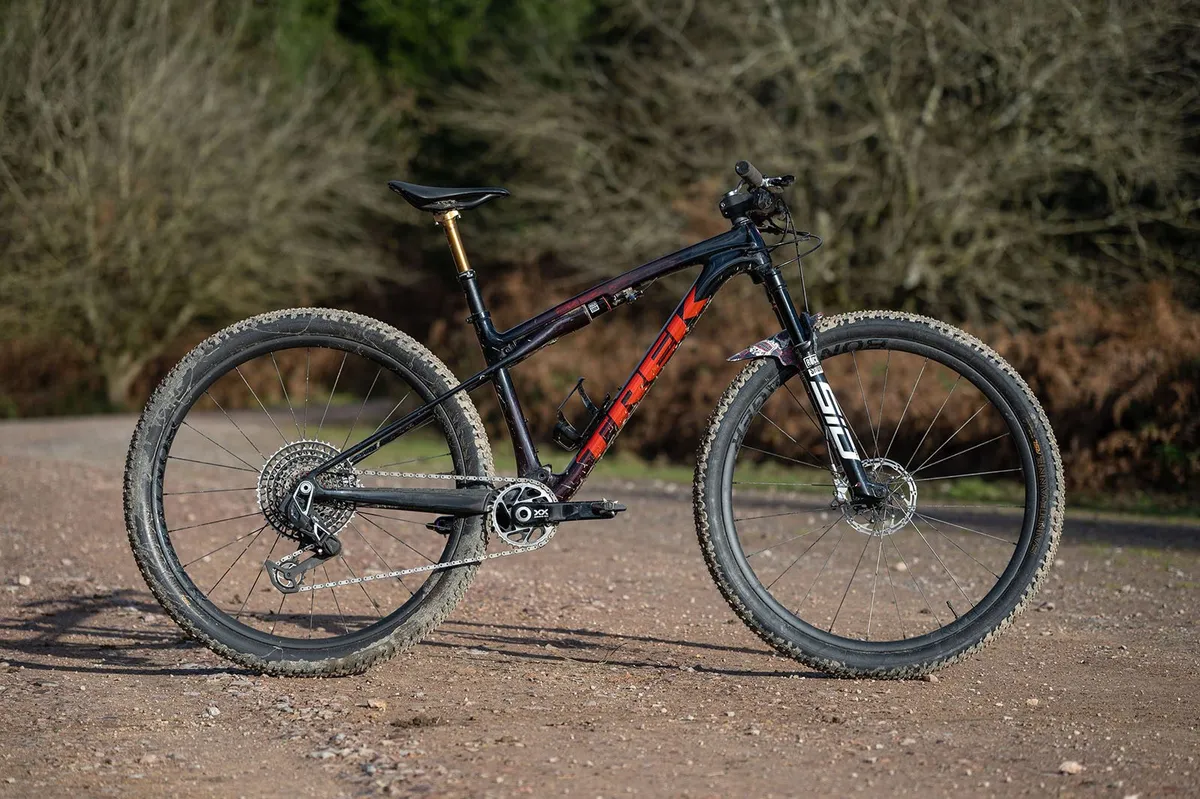
The Trek Supercaliber only has 5mm more bounce than the Specialized, but you set it up more like a regular mountain bike.
Like Specialized, Trek has designed the bike to offer the pedalling efficiency of a hardtail, but give you enough cushioning to handle the impacts and compressions you’re likely to encounter when hammering around a modern XC track.
While the US brand still sells its Procaliber hardtail, it’s been a while since we’ve seen any of Trek's racers rock up to the start line on one. Instead, it’s the Supercaliber that’s the firm favourite – a bike designed to bridge the gap between the Procaliber and longer-travel Top Fuel.
Trek has upped rear-wheel travel on the second-generation Supercaliber frames by 20mm to 80mm.
It’s controlled by the IsoStrut shock, developed in collaboration with RockShox. This is no ordinary shock: it’s designed to be an integral part of the frame structure in a bid to boost stiffness and pedal efficiency.
Up-front sits a top-tier 110mm-travel fork, while the parts bolted to this fancy frame are some of the best you can buy.
Specialized S-Works Epic World Cup vs Trek Supercaliber SLR 9.9 XX AXS Gen 2 frame details and geometry
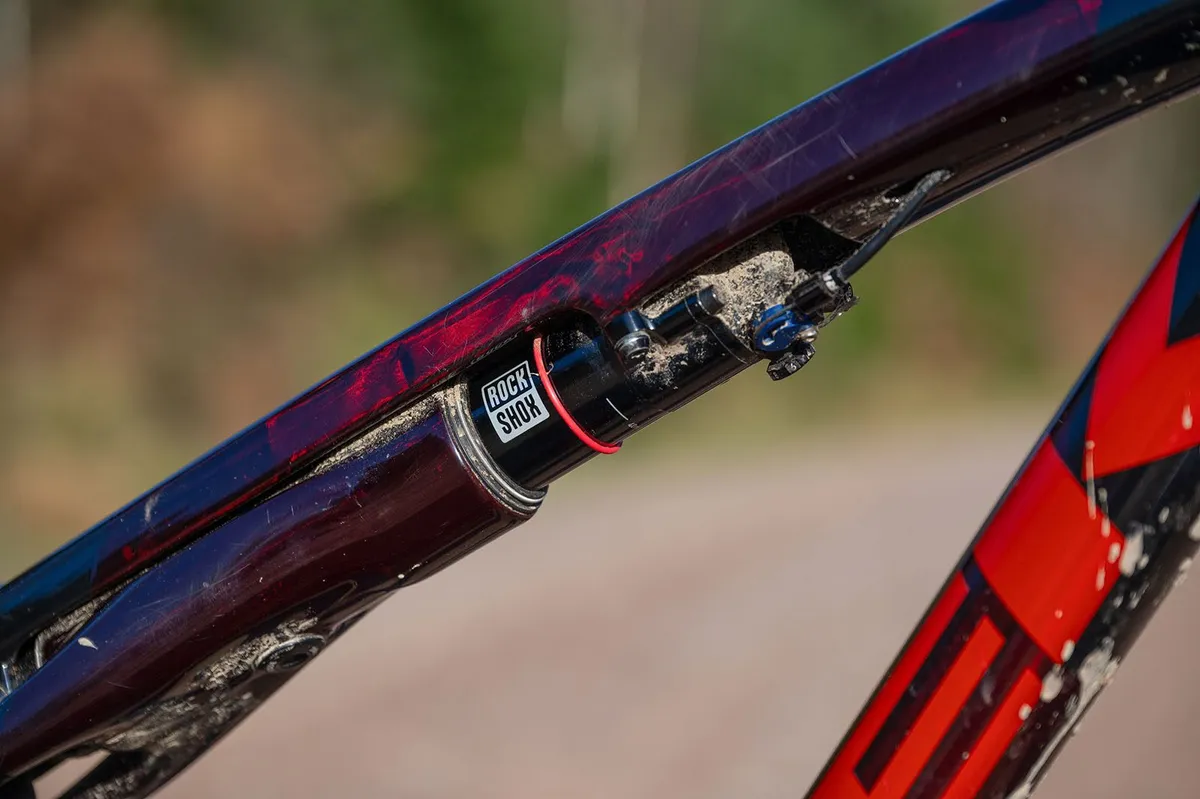
At the core of each of these bikes is a frame that makes them different from a lot of the competition, thanks largely to how their rear suspension works.
The S-Works moniker highlights that this is Specialized’s top-end chassis, built using its latest FACT 12m carbon fibre. Half-hidden within the top tube, the shock is driven by a tiny linkage.
At the rear, the stays flex a touch to allow for smooth movement of the suspension. Further forward, there’s space for a couple of bottle cages.
Cables run neatly inside the frame, entering via the headset. Shaped and smoothed stem spacers continue the sleek lines, while a sloped top tube gives the frame a compact look.
The Epic World Cup features geometry inspired by today’s ever-more-technical XC courses. At 66.5 degrees, the head angle is a full degree slacker than on the regular Epic.
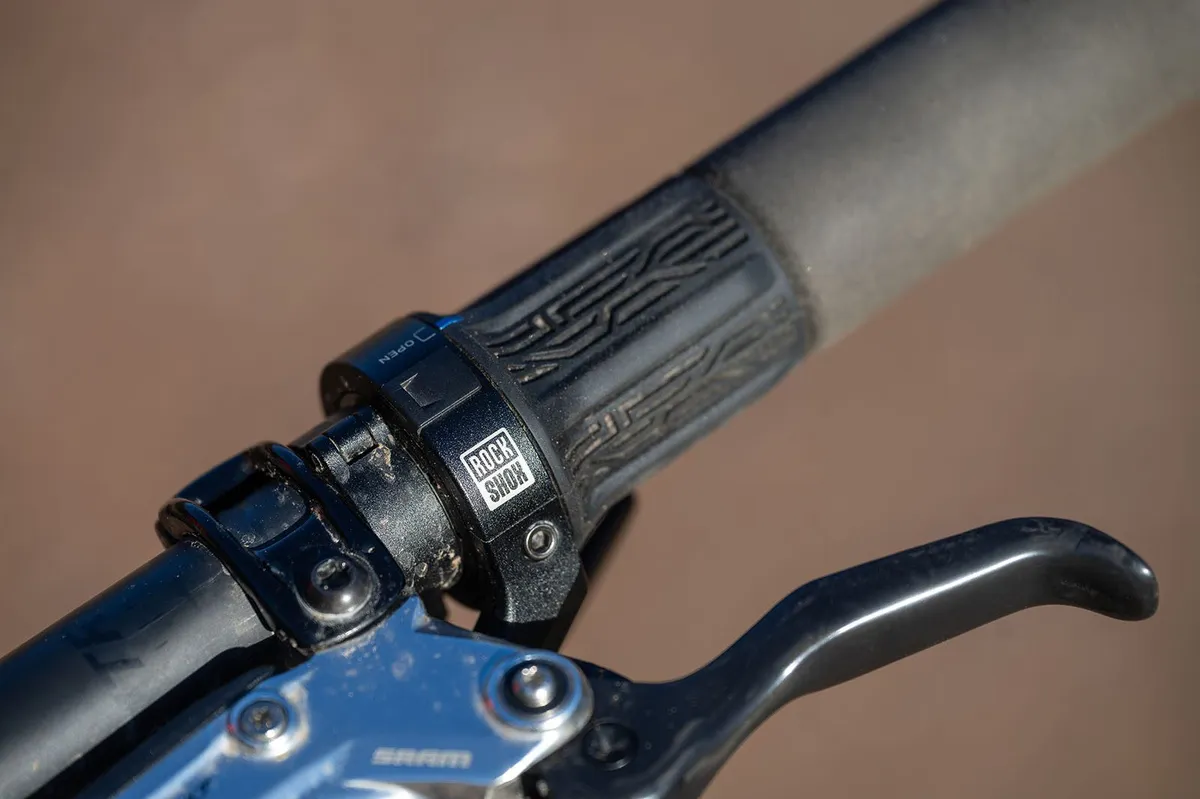
On paper, the seat tube angle is more relaxed, too, at 74.5 degrees. However, that figure won’t change much when the bike is weighted (due to the minimal sag), whereas on a normal full-sus bike, the dynamic geometry is often quite different from the static figures.
Specialized S-Works Epic World Cup geometry
| S | M | L | XL | |
|---|---|---|---|---|
| Stack (mm) | 600 | 600 | 614 | 628 |
| Reach (mm) | 415 | 440 | 465 | 490 |
| Head tube length (mm) | 93 | 95 | 110 | 125 |
| Head tube angle (degrees) | 66.5 | 66.5 | 66.5 | 66.5 |
| Bottom bracket height (mm) | 313 | 313 | 313 | 313 |
| Bottom bracket drop (mm) | 58 | 57 | 57 | 57 |
| Trail (mm) | 113 | 113 | 113 | 113 |
| Fork length (mm) | 516 | 516 | 516 | 516 |
| Fork offset (mm) | 44 | 44 | 44 | 44 |
| Front center (mm) | 701 | 726 | 757 | 788 |
| Chainstay length (mm) | 430 | 430 | 430 | 430 |
| Wheelbase (mm) | 1,124 | 1,150 | 1,181 | 1,212 |
| Standover height (mm) | 761 | 764 | 774 | 786 |
| Seat tube length (mm) | 395 | 410 | 450 | 500 |
| Seat tube angle (degrees) | 74.5 | 74.5 | 74.5 | 74.5 |
With Trek, it’s the SLR tag that highlights this bike’s top-tier ranking within the Supercaliber range. It’s made from higher-modulus carbon fibre than the SL version and also forgoes internal cable-guide tubes, to save weight.
Extended seatstays connect directly to the IsoStrut rear shock, eliminating all the usual hardware and creating a more solid connection from front to rear.
Down below, the chainstays extend past the main pivot and wrap around the base of the seat tube to bolster stiffness further.
As on the Specialized, there’s no rear pivot. Instead, the heavily shaped seatstays are designed to flex under compression. There’s ample room within the front triangle for two bottles.
Trek has slackened the Gen 2 Supercaliber’s head angle to 67.5 degrees, steepened the seat tube angle slightly to 74.5 degrees and extended the reach of the medium size to 435mm, which is 5mm shorter than that of the equivalent Epic World Cup.
Trek Supercaliber SLR 9.9 XX AXS Gen 2 geometry
| | S | M | ML | L | XL |
|---|---|---|---|---|---|
| Seat angle (degrees) | 74.5 | 74.5 | 74.5 | 74.5 | 74.5 |
| Head angle (degrees) | 67.5 | 67.5 | 67.5 | 67.5 | 67.5 |
| Chainstay (mm) | 435 | 435 | 435 | 435 | 435 |
| Seat tube (mm) | 395 | 420 | 440 | 460 | 525 |
| Top tube (mm) | 571 | 592 | 605 | 622 | 663 |
| Head tube (mm) | 90 | 90 | 90 | 100 | 125 |
| Fork offset (mm) | 43 | 43 | 43 | 43 | 43 |
| Trail (mm) | 109 | 109 | 109 | 109 | 109 |
| Bottom bracket drop (mm) | 46 | 46 | 46 | 46 | 46 |
| Bottom bracket height (mm) | 327 | 327 | 327 | 327 | 327 |
| Wheelbase (mm) | 1,113 | 1,138 | 1,153 | 1,172 | 1,217 |
| Standover (mm) | 760 | 772 | 772 | 772 | 772 |
| Stack (mm) | 590 | 590 | 590 | 599 | 622 |
| Reach (mm) | 410 | 435 | 450 | 465 | 500 |
Specialized S-Works Epic World Cup vs Trek Supercaliber SLR 9.9 XX AXS Gen 2 spec details

The Trek and Specialized share plenty of kit, and even the bits that aren’t identical are similar.
SRAM's XC-focused, wireless XX SL Eagle AXS Transmission drives both bikes forward, while Level Stealth Ultimate brakes bring them to a halt.
There are subtle differences, though. Trek has opted for the more powerful four-piston variant, while Specialized gives you the two-piston version, even though SRAM’s spec list indicates that the four-pot brakes are 9g lighter.
Both brands assume you’re happy pushing a 34t chainring, and tech-heads will appreciate the Quarq power meter built into the ring on the Epic World Cup.
RockShox suspension is used on both bikes. The Supercaliber’s IsoStrut SIDLuxe shock is paired with a regular SID SL Ultimate fork up-front, with 110mm of travel.
Specialized uses a custom SIDLuxe WCID Ultimate shock, and also drops its Brain damper into the top of the SID SL fork.

This adds an adjustable inertia valve platform, which keeps the fork effectively locked out under gentler inputs, but gives you access to the full 110mm of travel if a harsher or bigger shock bumps the valve open.
You get to decide just how sensitive the system is, too.
Trek’s approach to improving efficiency is a two-position lockout, operated from the handlebar via RockShox’s freshly revised TwistLoc remote.
Wheels and tyres play a crucial part in the performance of any XC bike, and both brands go to their in-house suppliers for these.
Carbon fibre hoops and skinny, fast-rolling rubber feature on both, but while the Specialized gets modern 2.4in tyres, the Trek rolls on relatively narrow 2.2in rubber (something we rectified early in testing).
Carbon fibre finishing kit is the name of the game.
Both bikes have integrated bar/stem setups, which save weight but deny the rider the opportunity to tune the fit and feel of the cockpit.
Further back, the Epic World Cup gets a rigid carbon post, while the Supercaliber has a Fox Transfer SL dropper fitted, with 100mm of travel on the medium bike tested here.
Specialized S-Works Epic World Cup specifications
- Frame: FACT 12m carbon fibre, 75mm travel
- Fork: RockShox SID SL Ultimate Brain, 110mm travel
- Shock: RockShox SIDLuxe WCID
- Wheelset: Roval Control SL carbon wheels
- Tyres: Specialized S-Works Fast Trak (f) and Specialized Renegade (r) 29x2.35in
- Drivetrain: SRAM XX SL Eagle AXS w/ Quarq power meter cranks (1x12)
- Brakes: SRAM Level Stealth Ultimate, 180/160mm rotors
- Bar/Stem: Roval Control SL Integrated, 60mm/760mm
- Seatpost: Roval Control SL rigid
- Saddle: Specialized S-Works Power
- Weight: 9.6kg, large size without pedals
- Price: £11,000
Trek Supercaliber SLR 9.9 XX AXS Gen 2 specifications
- Frame: SLR OCLV carbon fibre, 80mm travel
- Fork: RockShox SID SL Ultimate, 110mm travel
- Shock: Trek IsoStrut RockShox SIDLuxe
- Wheelset: Bontrager Kovee RSL carbon wheels
- Tyres: Bontrager Saint-Anne RSL XR 29x2.2in
- Drivetrain: SRAM XX SL Eagle AXS (1x12)
- Brakes: SRAM Level Ultimate Stealth, 160mm rotors
- Bar/Stem: Bontrager RSL Integrated, 750mm/70mm
- Seatpost: Fox Transfer SL, 100mm drop
- Saddle: Bontrager Aeolus RSL
- Weight: 9.62kg, medium size without pedals
- Price: £10,800
Specialized S-Works Epic World Cup vs Trek Supercaliber SLR 9.9 XX AXS Gen 2 ride comparisons

In No Gulp (firm) mode, with zero shock sag and its most progressive spring rate, the Epic World Cup really does have the demeanour of a hardtail. The rear end is solid, barely breaking into its travel until an impact requires it.
Stand on the pedals and the fast-rolling Renegade rear tyre instantly spins up to speed, but take care on slippery, slimy surfaces because the slick tread and stiff suspension can make technical ascents a spicy affair.
Although the Supercaliber sags into its travel, get on the power and you’ll be surprised by just how taut and direct things are.
It may not feel quite as solid as the Epic World Cup in an all-out sprint, but there’s no denying just how stable it is or how quickly it picks up pace.
Hit a technical climb at speed on the Specialized and the rear soaks up the harsh edges, underlining that it certainly isn’t a hardtail.
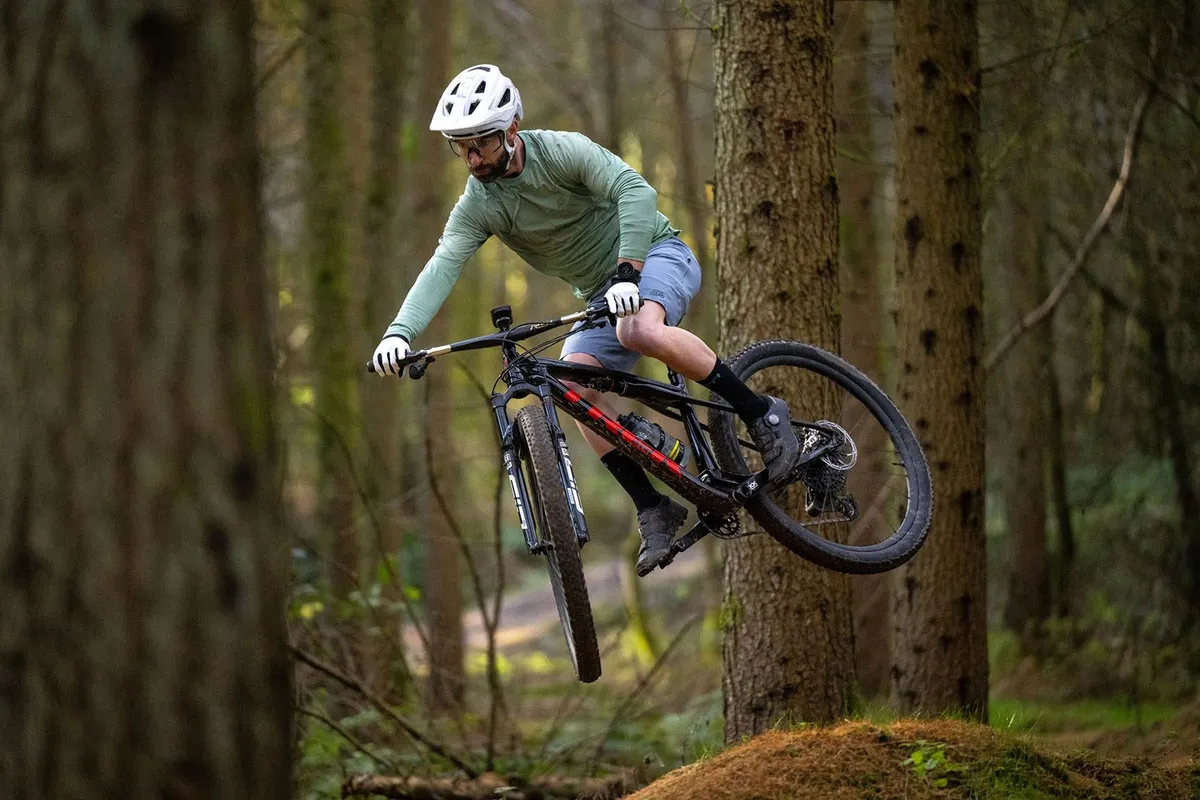
Switch to Full Gulp (active) mode – by pressing the button on the shock, which transfers air from the positive to the negative chamber, giving 10 per cent sag and a more linear spring rate – and it only gets better on chunky uphill sections.
It’s still direct and efficient-feeling, but with that little extra sag, the bike turns into a mountain goat.
The tyres may be scantily treaded, but the suspension helps them grip tenaciously, while remaining relatively stable and not causing any pedal-tempo-ruining lurches.
With the fork settled deeper into its travel than the rear, the seat tube steepens, further boosting pedalling.
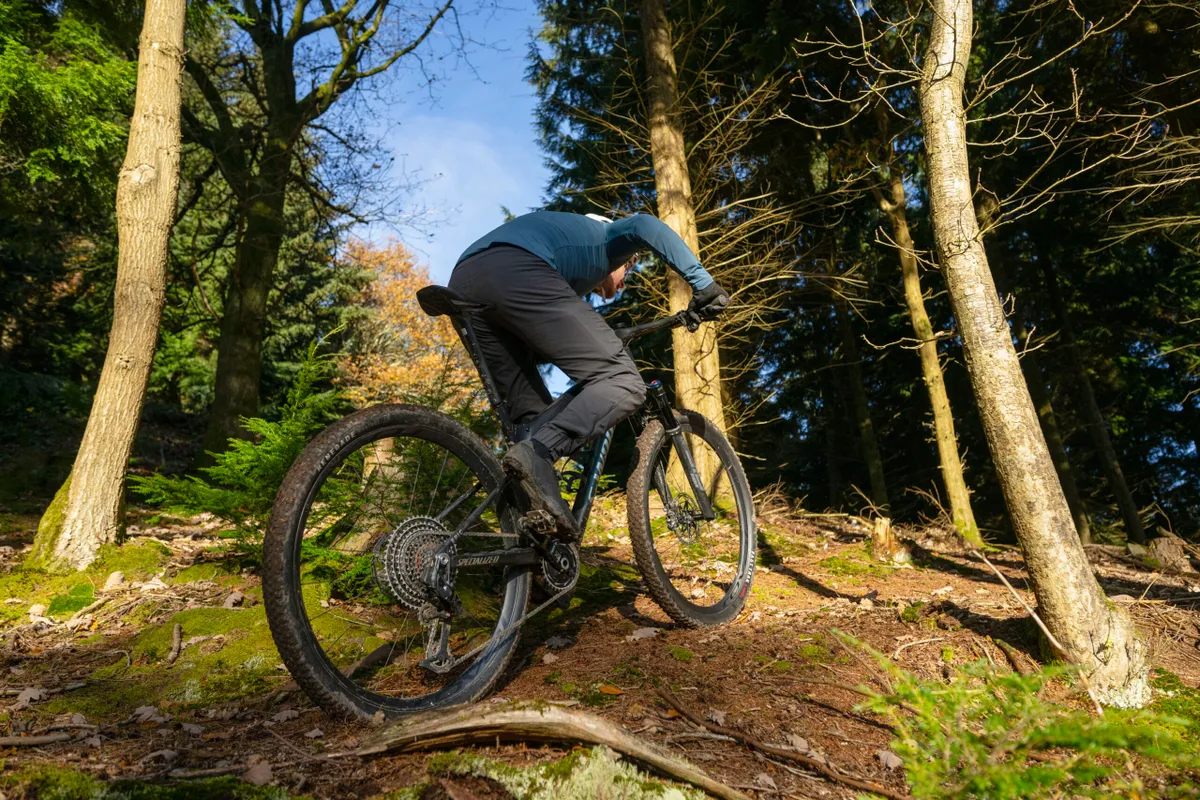
The intermediate Half Gulp setting ‘gulps’ a little less air into the negative chamber than Full Gulp, for a feel somewhere between the other two modes. Breakaway force is reduced compared to No Gulp, giving a suppler start to the stoke.
While the Trek’s shock is less fancy, it too provides a super-stable platform to pedal from, with the rear end barely moving as you spin the cranks. This makes the Supercaliber feel sprightly and eager to claw its way up any incline.
When you do encounter a rock-step or root, the rear wheel can still move freely enough to take the edge off the impact, boost traction and keep you feeling unflustered as you continue to power up the hill.
Even awkward, technical uphill switchbacks can be dispatched with relative ease, with plenty of control and next to no front-wheel lift or wander.
Specialized S-Works Epic World Cup vs Trek Supercaliber SLR 9.9 XX AXS Gen 2 descending comparison

The best cross-country bikes must excel on the climbs, but they need to feel relatively composed and confident on faster-paced trails and descents, too.
With its slack-for-XC head angle and decent reach, the Specialized’s front centre is pretty long. On smooth, flowing trails, this gives the bike plenty of stability.
Whether you keep it in No Gulp, Half Gulp or Full Gulp, this is a bike that thrives when you push and pump through the terrain, or stab at the pedals to boost speed.
The Supercaliber feels more like a traditional full-suspension XC bike, albeit one with quite heavy damping, but it still gives a sensation of urgency and eagerness on mellower trails.
Point the Epic World Cup down something more gnarly and the bike surprises.
With the Brain valve shifting smoothly from closed to open, there’s often a hint of forward bias, as the fork settles deeper into its travel while the shock remains propped up higher in its stroke.
This means you can end up weighting the front wheel more than is necessary (the fixed seatpost doesn’t help here, either).

However, with more travel to play with at the front than the back, and the understanding that the rear suspension is there more to take the edge off the hits than flatter your descending prowess, you can adjust.
The fork’s mid-stroke support helps keep the front end propped up, too.
In all three modes, the Specialized delivers all its travel as and when needed, with a smooth transition to the end of the shock stroke, thanks to the Mega Jounce Bumper – basically, a bottom-out bumper.
The difference between the Full Gulp and No Gulp settings is most clear when you dive into a set of loose corners.
With zero sag, the rear wheel is reliant on the tyre’s low tread blocks alone to create grip.
However, shift some air into the negative chamber, and that little extra suppleness immediately boosts grip and confidence.

Get up out of the saddle on the Supercaliber and you feel more centred, with the suspension remaining more balanced and the dropper post enabling you to slam the seat out of the way.
This makes for a more controlled and confident stance on the bike. A little like on the Epic World Cup, the rear suspension is there to soak up and quell impacts, rather than totally absorb them.
That means more feedback through the chassis, but thankfully, there’s enough give and progression within the system to enable you to make the most of that 80mm of rear-wheel travel, stick lines older XC hardtails would baulk at and do so without feeling uncomfortable or out of your depth.
The four-piston calipers on the Trek help when descending, too, especially in treacherous conditions, where the boost in power and punch gives extra confidence.
Specialized’s tyres blow up broad on their Roval rims and, with thin sidewalls, have a supple feel, which helps reduce buzz and boost grip.
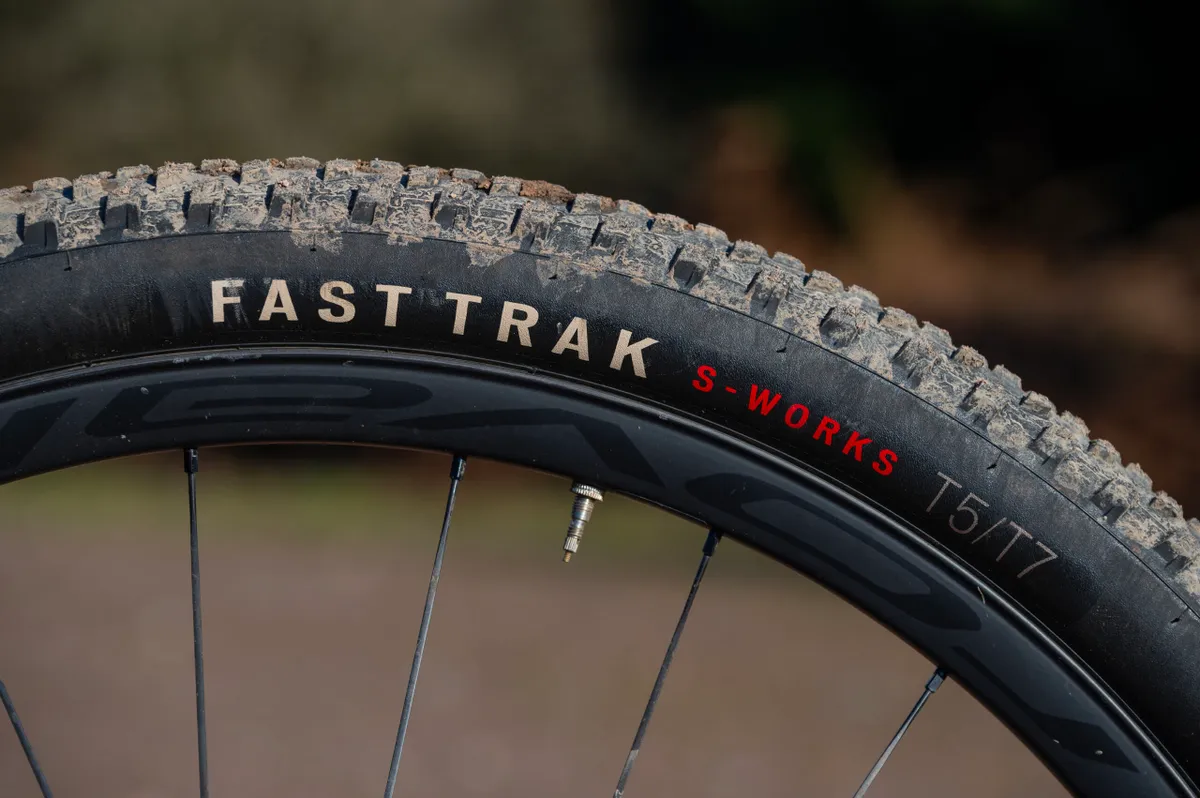
While the tread blocks are low in profile, they’re well-placed and, especially up-front, have sharp enough edges to dig into XC-style surfaces.
Come winter, something with a more aggressive tread is likely to be on your shopping list, though.
The rubber that comes as standard on the Supercaliber is also superbly pliant, but at 2.2in, the tyres just aren’t wide enough.
Trek sent us some replacement 2.4in Saint-Annes. With these fitted, more trail chatter was eliminated and grip felt easier to find in slimy rock sections.
Both of our testers struggled with the integrated cockpits on these bikes, which share similar rise and sweep figures. Unable to roll the bars into a different position, they found it hard to keep their hands comfy, especially on rougher trails and longer rides.
Specialized S-Works Epic World Cup vs Trek Supercaliber SLR 9.9 XX AXS Gen 2 bottom line
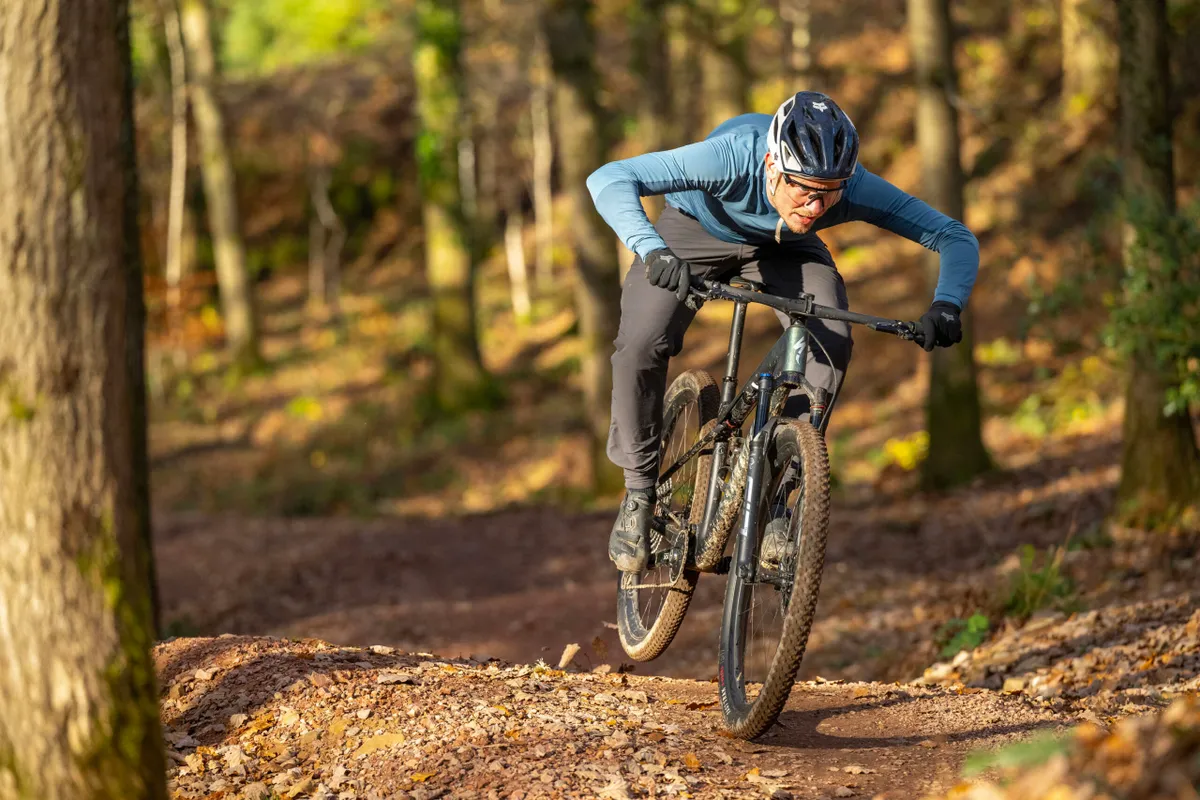
The Epic World Cup is, to all intents and purposes, a niche bike. Short-course XC racers who love putting in 100 per cent effort on every lap will love its tenacious approach to speed.
However, marathon racers may benefit from more travel to make long days and prolonged descents a little more palatable.
The Trek is arguably more of an all-rounder, thanks to how that 80mm of rear-wheel travel is delivered.
There’s no denying just how formidable this machine is when you get on the gas, though.

As with the Epic World Cup, put the power down and the Supercaliber surges forward at breakneck speed.
But there’s enough squish to soften impacts sufficiently to boost comfort on longer rides. It helps massively that the bike comes with a dropper post, which elevates control further.
On both of these bikes, acceleration and pick-up is almost instantaneous and there are certainly hints of a hardtail coursing through each of these frames.
But, when it comes to maximising the number of watts going through the rear wheel, the Epic World Cup just edges ahead.
It’s a touch more direct and solid-feeling in these up-out-of-the saddle situations, which makes it a seriously eager climber.
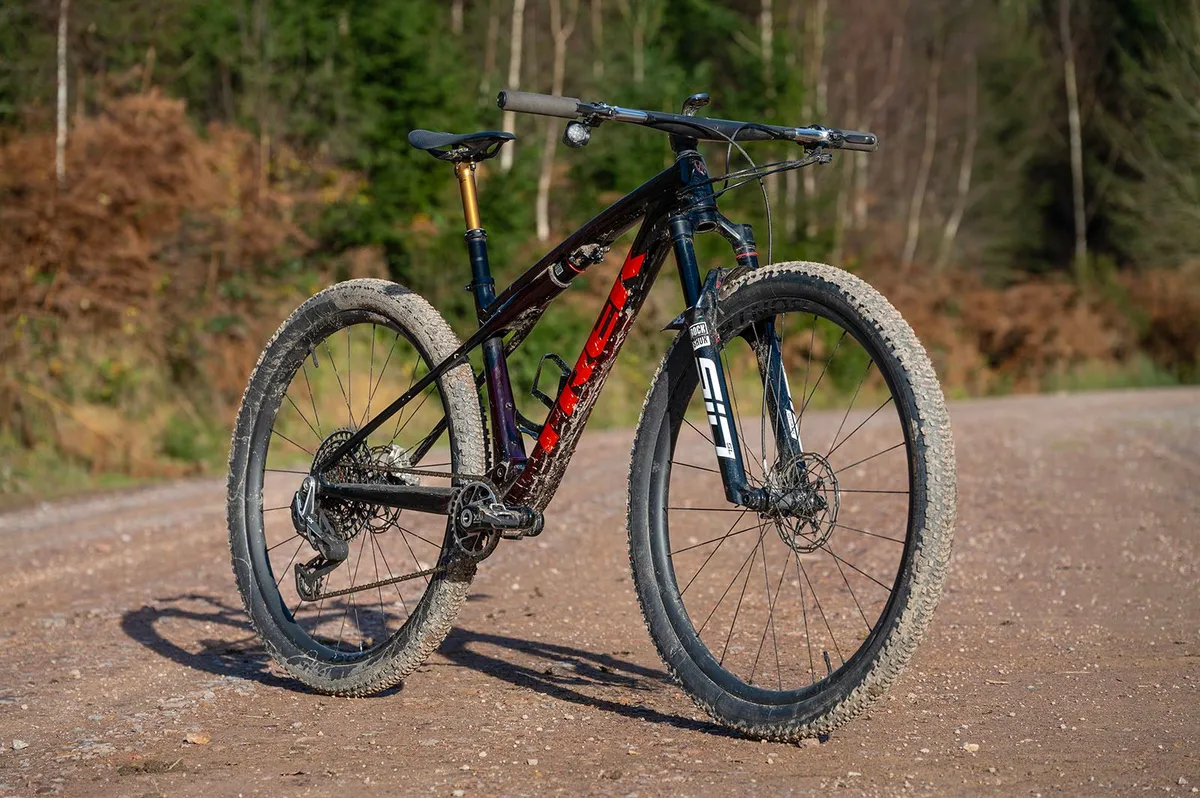
Get into more technical, undulating terrain and the Trek gains the upper hand. The back end of the bike is that bit more forgiving on choppy, roughed-up sections of trail.
Couple this with the dropper post, and when it comes to descending, the Supercaliber offers a well-centred ride position that feels confidence-enhancing and controllable.
The Epic World Cup can’t quite keep up with its rival.
Both bikes are dripping with some of the best XC-focused kit going, although some of the spec choices are somewhat questionable.
Overall, though, it’s the Trek that offers the better all-round performance, whether for shorter, sharper efforts, or longer stints in the saddle.
undefinedundefinedundefinedundefinedundefinedundefinedundefinedundefinedundefinedundefinedundefinedundefinedundefinedundefinedundefinedundefinedundefinedundefinedundefinedundefinedundefinedundefinedundefinedundefinedundefinedundefinedundefinedundefinedundefinedundefinedundefinedundefinedundefinedundefinedundefinedundefinedundefinedundefinedundefinedundefinedundefinedundefinedundefinedundefinedundefinedundefinedundefinedundefinedundefinedundefinedundefinedundefinedundefinedundefinedundefinedundefinedundefinedundefinedundefinedundefinedundefinedundefinedundefinedundefinedundefinedundefinedundefinedundefinedundefinedundefinedundefinedundefinedundefinedundefinedundefinedundefinedundefinedundefinedundefinedundefinedundefinedundefinedundefinedundefinedundefinedundefinedundefinedundefinedundefinedundefined
